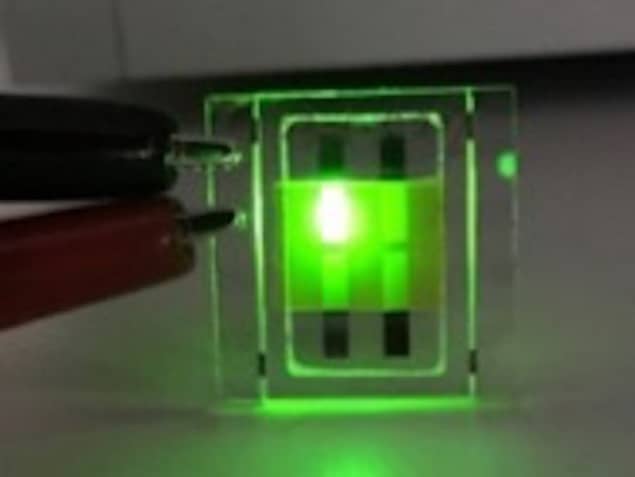
Researchers in Japan have found that the performance of light-emitting diodes (LEDs) made from quasi-2D perovskites depends on the behaviour of excitons within the material. This advance in our understanding could make it easier to develop more efficient perovskite-based optoelectronic devices.
2D and quasi-2D perovskites are often touted as an alternative to silicon in optoelectronics. 2D perovskites are made up stacked sheets of alternating organic and inorganic layers. Quasi-2D perovskites are slightly different in that they contain small regions where organic and inorganic materials alternate in all directions, as is the case in 3D perovskites. The quasi-2D versions also incorporate two different types of organic material: one for the 3D domains and one for the 2D organic sheets between them.
In the new study, researchers led by Chihaya Adachi of Kyushu University’s Center for Organic Photonics and Electronics Research studied how changes to the composition of the organic sheets affect the efficiency of LEDs made from these quasi-2D perovskites. The perovskites in question have an A2Bn−1CnX3n+1 structure, where A is phenylethylammonium (PEA) or 1-naphthylmethylamine (NMA), B is methylammonium (MA) or formamidinium (FA), B is lead or tin and X is chlorine, bromine or iodine. In particular, Adachi and colleagues investigated quasi-2D perovskites based on PEA and NMA formadinium lead bromide (PEA2/NMA2FAn-1PbnBr3n+1).
Organic vs inorganic
As 2D and quasi-2D perovskites contain a combination of inorganic and organic components, there has been much discussion about whether their semiconducting properties are better described by models for inorganics or organics. In organic semiconductors, charges come together when they are electrically excited to form an energetic state called an exciton. This exciton may exist in a singlet state, which has no net spin because the contributing electron spins point in opposite directions, or in a triplet state where the spins point in the same direction. In either case, the energy in the exciton can then be released as light via a process known as radiative recombination. However, triplets generally have a lower energy than singlets, and therefore do not emit as much light.
After other researchers reported the existence of excitons in some perovskites, Adachi’s team decided to look at the material from an organic semiconductor perspective. One key property of organic LEDs is that the triplet energies of periphery materials (that is, materials other than the active light-emitting ones) are higher than that of the emitting layer itself. This means that when radiative recombination occurs, the energy from the triplet is transferred from the periphery to the emitting layer, rather than being lost.
To see whether their quasi-2D perovskite behaves in a similar fashion, the researchers examined how the triplet energy of one of the organic components (PEA or NMA) in the perovskite LED affects how much light it emits. They found that when NMA is used and the triplet exciton energy is low, light-emitting performance significantly drops. They also found that replacing the NMA with PEA, which has a higher triplet energy, improves performance.
Diverted triplet energy is not lost
“This, along with other studies on the energy dynamics in films and devices, convinced us that [in the NMA device] energy in triplets was being lost to an organic component that does not emit light,” explains study lead author Chuanjiang Qin. In the PEA device, in contrast, the researchers see a similar pattern as in organic LEDs, with the energy from triplet states ending up in the lower-energy light-emitting part of the material. “Quenching of triplets by the organic is thus a major energy loss path that we must take into account when thinking about applications,” Qin concludes.

2D perovskites make brilliant blue-light emitters
The researchers also found that the energy gap between the singlet and triplet states in their PEA-based perovskite is small, at just 0.02 eV. This means that triplets can “upconvert” into singlets by adsorbing a small amount of (thermal) energy from the environment. The number of light-emitting singlets can thus be increased. “Converting all the triplets in the material into singlets would mean that all the energy available could be harvested for light emission,” Qin tells Physics World. “Indeed, the external quantum and current efficiencies of our green (527 nm) devices reached 12.4% and 52.1 cd A−1, respectively.”
Favourable properties
Perovskites of this type can be fabricated from low-cost starting materials in simple solution-based processes, and their high colour purity and performance make them one of the most promising thin-film LED materials available. Another favourable property is that charge carriers (electrons and holes) diffuse through them quickly and over long distances. Overall, the light-emitting efficiencies of diodes made from these materials have skyrocketed from an initial 0.1% (in 2014) to nearly 20% recently, bringing them on a par with established technologies. Researchers would like to continue improving this figure, but to do this they need to find out what exactly influences this efficiency – especially for green light emission, which is a key colour for displays and other applications.
The results from this study provide us with a better picture of how to achieve highly efficient LEDs based on perovskites, Qin says. “These materials show great promise for solar cells, transistors and other electronics devices, so a better understanding of their physics will help in the future development of these applications.”
The work is detailed in Nature Photonics.



